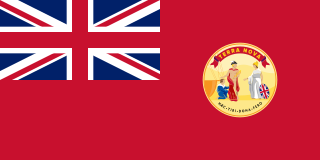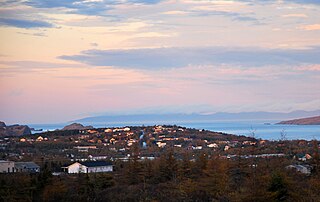The 11th Newfoundland general election was held in 1869 to elect members of the 10th General Assembly of Newfoundland in the Dominion of Newfoundland. 21 Anti-Confederates (A-C) were elected against 9 Confederates (Con), ending for a moment the debate over joining the Dominion of Canada.

The 29th Newfoundland general election was held on 11 June 1932 to elect members of the 28th General Assembly of Newfoundland. This vote proved to be the final general election held by the Dominion of Newfoundland. As a result of a riot which occurred in 1932 due to Newfoundland's deteriorating economic situation, Prime Minister Sir Richard Squires dissolved the House of Assembly and called an election. His Liberals were reduced to two seats while Frederick C. Alderdice's United Newfoundland Party won 24 seats and was elected to government. The size of the House was reduced from 40 to 27 as an economy measure.
The 9th Newfoundland general election was held in 1861 to elect members of the 8th General Assembly of Newfoundland in the Dominion of Newfoundland. 14 Conservatives and 12 Liberals were elected. The results in Harbour Grace and Harbour Main electoral districts were set aside following violence at the polls; members were elected in subsequent by-elections. The Liberal Party led by John Kent was defeated by the Conservatives led by Hugh Hoyles; Ambrose Shea replaced Kent as party leader.

The 8th Newfoundland general election was held in 1859 to elect members of the 7th General Assembly of Newfoundland in the Dominion of Newfoundland. 18 Liberals and 12 Conservatives were elected. The Liberal Party led by John Kent formed the government.
The 7th Newfoundland general election was held in 1855 to elect members of the 6th General Assembly of Newfoundland. This was the first election after responsible government was introduced to the Dominion of Newfoundland. The Liberal Party led by Philip Francis Little formed the government.
The 5th Newfoundland general election was held in 1848 to elect members of the 4th General Assembly of Newfoundland in the Dominion of Newfoundland. The use of two separate bodies, an elected assembly and an appointed Legislative Council, was resumed; the experiment with combining the two bodies which had been initiated in 1842 was terminated. While the exact party composition of the Newfoundland House of Assembly following this election is unknown; the Liberals did enjoy a majority.
The 15th Newfoundland general election was held in 1882 to elect members of the 14th General Assembly of Newfoundland in the Dominion of Newfoundland. The Conservative Party led by William Vallance Whiteway formed the government.

The 13th Newfoundland general election was held in 1874 to elect members of the 12th General Assembly of Newfoundland in the Dominion of Newfoundland. The Conservative Party led by Frederick Carter formed the government.
The 14th Newfoundland general election was held in 1878 to elect members of the 13th General Assembly of Newfoundland in the Dominion of Newfoundland. The Conservative Party led by William Vallance Whiteway formed the government.
The 2nd Newfoundland general election was held in 1836 in the Colony of Newfoundland. The results of the election were set aside by Henry John Boulton after he discovered some of the writs from the election had not been marked with the official seal. Some felt that this was a pretext used because Liberal reformers had dominated the assembly and a number who had been reelected in 1836 did not run for reelection the following year.
The 17th Newfoundland general election was held on 6 November 1889 to elect members of the 16th General Assembly of Newfoundland in the Dominion of Newfoundland. The Reform Party administration of Robert Thorburn was defeated in favour of the Liberal Party led by William Whiteway formed the government. Reform soon disappeared and was replaced by the Orange Order based Tory Party. This was the first general election held in Newfoundland using the secret ballot.
The 19th Newfoundland general election was held on 28 October 1897 to elect members of the 18th General Assembly of Newfoundland in the Dominion of Newfoundland. The Tory Party led by James Spearman Winter formed the government. On February 15, 1900, the government was defeated following a vote on a motion of no confidence which was supported by the Liberals and several Tories.
The 20th Newfoundland general election was held on 8 November 1900 to elect members of the 19th General Assembly of Newfoundland in the self-governing British colony. The Liberal Party led by Robert Bond formed the government. The unpopular railway policy of the Conservatives contributed to their defeat at the polls. The Tory government of James Spearman Winter was defeated largely due to its railway policy and his conservative party fell into disarray.
The 21st Newfoundland general election was held on 31 October 1904 to elect members of the 20th General Assembly of Newfoundland in the Dominion of Newfoundland. The Liberal Party led by Robert Bond formed the government.
The 22nd Newfoundland general election was held on 2 November 1908 to elect members of the 21st General Assembly of Newfoundland in the Dominion of Newfoundland. The seats were split evenly between the Liberal Party and the new Newfoundland People's Party formed by Edward Morris after he resigned from the Liberal government in 1907 and joined with the opposition. Robert Bond, the Liberal leader, asked the Governor William MacGregor to dissolve the assembly. MacGregor refused to do this and Bond resigned as Premier. The Governor asked Edward P. Morris to form a government. The assembly was not able to elect a speaker and, after the Governor was unable to convince the two party leaders to form a coalition government, the house of assembly was dissolved on April 9, 1909.

The 23rd Newfoundland general election was held on 8 May 1909 to elect members of the 22nd General Assembly of Newfoundland in the Dominion of Newfoundland. The Newfoundland People's Party led by Edward P. Morris, having secured a majority, formed the government.

The 24th Newfoundland general election was held on 30 October 1913 to elect members of the 23rd General Assembly of Newfoundland in the Dominion of Newfoundland. The Liberal Party led by Robert Bond formed a coalition with the Fishermen's Protective Union led by William Coaker. Although the majority held by the Newfoundland People's Party was reduced in this election, it was again returned to power and Edward P. Morris continued to serve as Prime Minister of Newfoundland. A general election originally scheduled for 1917 was deferred until 1919 because of World War I. After Morris retired from politics in 1918, William F. Lloyd, a Liberal member of the Executive Council, was asked to form a government. In May 1919, Michael Patrick Cashin, the leader of the People's Party, introduced a motion of no confidence which resulted in the defeat of the government. Cashin served as Newfoundland prime minister until the election held later in 1919.
The 25th Newfoundland general election was held on 3 November 1919 to elect members of the 24th General Assembly of Newfoundland in the Dominion of Newfoundland. The Liberal Reform Party, an alliance between the Liberals led by Richard Squires and the Fishermen's Protective Union of William Coaker, formed the government. The People's Party, became the Liberal-Labour-Progressive party following the election and formed the opposition. Squires served as Newfoundland prime minister.

The 26th Newfoundland general election was held on 3 May 1923 to elect members of the 25th General Assembly of Newfoundland in the Dominion of Newfoundland. The Liberal Reform Party, an alliance between the Liberals led by Richard Squires and the Fishermen's Protective Union of William Coaker, formed the government. The Liberal-Labour-Progressive party, now led by William J. Higgins, formed the opposition. Squires was forced to resign as Prime Minister in 1923 after allegations of corruption were brought forward. William Warren became Liberal Reform Party leader and Prime Minister. After Warren's government was defeated following a motion of no confidence, Albert Hickman was asked to form a government and Warren joined Higgins in a new Liberal-Conservative Progressive Party.

The 27th Newfoundland general election was held on 2 June 1924 to elect members of the 26th General Assembly of Newfoundland in the Dominion of Newfoundland. The Liberal-Progressives and Liberal-Conservative Progressives were new parties formed as a result of the collapse of the ruling Liberal Reform Party. The Liberal-Conservative Progressives were led by Walter Stanley Monroe and won the election weeks after the party's creation. During his time in office, Monroe alienated a number of his supporters: Peter J. Cashin, F. Gordon Bradley, C. E. Russell, Phillip F. Moore, Lewis Little and H.B.C. Lake, who all defected to the opposition Liberal-Progressive Party. In 1926, universal suffrage was introduced in Newfoundland: women over the age of 25 were allowed to vote. Monroe was replaced by Frederick C. Alderdice as Prime Minister in August 1928.









